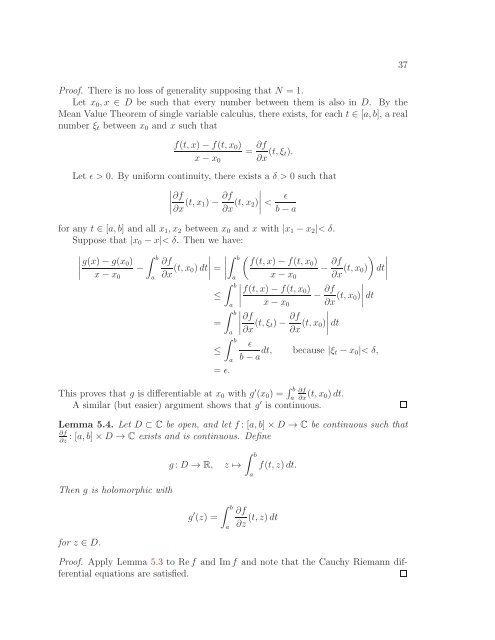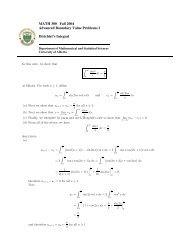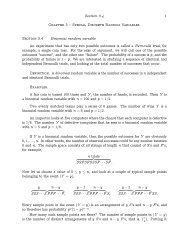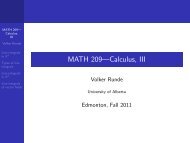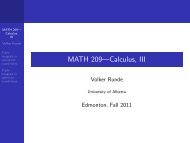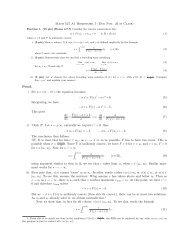Math 411: Honours Complex Variables - University of Alberta
Math 411: Honours Complex Variables - University of Alberta
Math 411: Honours Complex Variables - University of Alberta
Create successful ePaper yourself
Turn your PDF publications into a flip-book with our unique Google optimized e-Paper software.
Pro<strong>of</strong>. There is no loss <strong>of</strong> generality supposing that N = 1.<br />
Let x0,x ∈ D be such that every number between them is also in D. By the<br />
Mean Value Theorem <strong>of</strong> single variable calculus, there exists, for each t ∈ [a,b], a real<br />
number ξt between x0 and x such that<br />
f(t,x)−f(t,x0)<br />
x−x0<br />
= ∂f<br />
∂x (t,ξt).<br />
Let ǫ > 0. By uniform continuity, there exists a δ > 0 such that<br />
�<br />
�<br />
�<br />
∂f ∂f<br />
� (t,x1)−<br />
∂x ∂x (t,x2)<br />
�<br />
�<br />
�<br />
ǫ<br />
� <<br />
b−a<br />
for any t ∈ [a,b] and all x1,x2 between x0 and x with |x1 −x2|< δ.<br />
Suppose that |x0 −x|< δ. Then we have:<br />
� �<br />
�<br />
b<br />
�<br />
g(x)−g(x0) ∂f<br />
� −<br />
x−x0 a ∂x (t,x0)dt<br />
�<br />
�<br />
�<br />
� =<br />
��<br />
� b�<br />
�<br />
f(t,x)−f(t,x0)<br />
� −<br />
a x−x0<br />
∂f<br />
∂x (t,x0)<br />
� �<br />
�<br />
dt�<br />
�<br />
� � b�<br />
≤ �<br />
f(t,x)−f(t,x0)<br />
� −<br />
a x−x0<br />
∂f<br />
∂x (t,x0)<br />
�<br />
�<br />
�<br />
�dt � � b�<br />
= �<br />
∂f ∂f<br />
� (t,ξt)−<br />
a ∂x ∂x (t,x0)<br />
�<br />
�<br />
�<br />
�dt � b<br />
ǫ<br />
≤<br />
b−a dt, because |ξt −x0|< δ,<br />
= ǫ.<br />
This proves that g is differentiable at x0 with g ′ (x0) = � b<br />
a<br />
A similar (but easier) argument shows that g ′ is continuous.<br />
a<br />
∂f<br />
∂x (t,x0)dt.<br />
Lemma 5.4. Let D ⊂ C be open, and let f: [a,b]×D → C be continuous such that<br />
: [a,b]×D → C exists and is continuous. Define<br />
∂f<br />
∂z<br />
Then g is holomorphic with<br />
for z ∈ D.<br />
� b<br />
g: D → R, z ↦→ f(t,z)dt.<br />
g ′ � b<br />
(z) =<br />
a<br />
a<br />
∂f<br />
∂z (t,z)dt<br />
Pro<strong>of</strong>. Apply Lemma 5.3 to Ref and Imf and note that the Cauchy Riemann differential<br />
equations are satisfied.<br />
37


